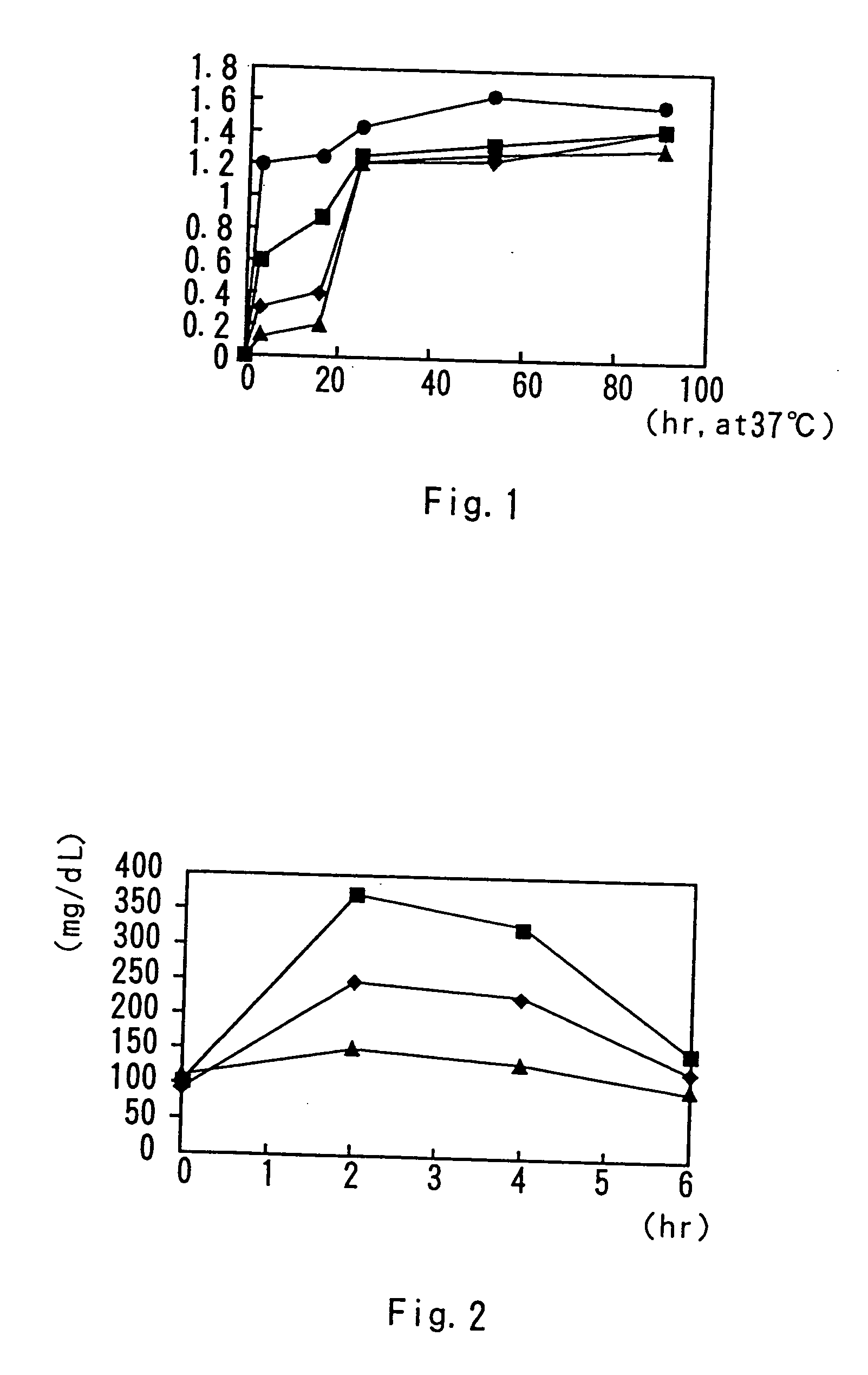Conjugated fatty acid esters
a technology ester structures, which is applied in the direction of drug compositions, dispersed delivery, and metabolic disorders, can solve the problems of inability to fully absorb conjugated linoleic acids, difficulty in incorporation or addition poor digestion and absorption of conjugated fatty acids, etc., to achieve the suppression of bitterness and astringency specific to conjugated fatty acids, and the effect of improving digestion and absorption properties
- Summary
- Abstract
- Description
- Claims
- Application Information
AI Technical Summary
Benefits of technology
Problems solved by technology
Method used
Image
Examples
example 1
Conjugated Linoleic Acid Glyceride Production 1; Ester Exchange Reaction
[0056] In a 300-mL medium bottle were placed an enzyme Lipase PL (1 g), 400 mL of water, 95 mL of hexane, and 58 g each of butter oil, coconut oil or corn oil or 69 g of sardine oil, followed by addition of Active Linol (product name; manufactured by RINORU OIL MILLS, Co., Ltd.; containing conjugated linoleic acid at 73.6%), and then, nitrogen was filled in the bottle for sealing. The resulting mixture reacted together under agitation with a reciprocal agitator at 37° C. for 91 hours. At a predetermined interval, a sample of 10 mL was collected and diluted, for thin layer chromatography analysis. The results are shown in FIG. 1. Because the fatty acid in the fats and oils and the conjugated linoleic acid were set at equivalent moles for the reaction, the value of the conjugated linoleic acid in the glyceride when the reaction reached equilibrium was calculated as 1.5. It is indicated that the content of conjuga...
example 2
Conjugated Linoleic Acid Glyceride Production 2; Ester Synthesis Reaction
[0057] 100 g of CLA 80 (product name; manufactured by RINORU OIL MILLS, Co., Ltd.), 11 g of glycerol (for food additives) and 11.3 g of Lipozyme IM (product name; manufactured by Novo Nordisk, Co., Ltd.) are weighed in a round bottom flask. While the mixture was dried and solidified under reduced pressure in a rotary evaporator, the mixture was agitated at about 70° C., for ester synthesis reaction for 12 hours. Lipozyme IM was filtered and recovered from the reaction product, to recover conjugated linoleic acid glyceride. The resulting reaction product was determined by thin layer chromatography and iodine color reaction. Consequently, triglyceride was at 85.5%; diglyceride, at 13.5%; monoglyceride, at 1% or less; unreactive fatty acid, at 4%; and unreactive glycerol, at 2% or less.
example 3
Screening of Lactic Acid Bacteria
[0058] Bacteria with a potency reacting with fats and oils containing linoleic acid to directly generate conjugated linoleic acid were screened. First, various lactic acid bacteria shown in Tables 1 and 2, bacteria of the genus Bifidobacterium and bacteria of the genus Propionibacterium were cultured in 0.035% linoleic acid-containing MRS culture medium; the bacterial cells were harvested by centrifugation and rinsed in physiological saline to prepare rinsed bacterial cell. Further, the bacteria of the genus Eurobacterium were treated in the same manner as described above, except for cultivation under anaerobic conditions using a BCM culture medium as the culture medium therefor.
[0059] These rinsed fresh bacterial cells of 100 mL were mixed in 1 mL of 50 mM phosphate buffer, pH 7.1 containing 5 mg of linoleic acid, for shaking at 37° C. for 2 days, for reaction. After subsequent centrifugation and extraction of the supernatant in the 2-fold volume ...
PUM
| Property | Measurement | Unit |
|---|---|---|
| Percent by mass | aaaaa | aaaaa |
| Mass | aaaaa | aaaaa |
| Mass | aaaaa | aaaaa |
Abstract
Description
Claims
Application Information
 Login to View More
Login to View More - R&D
- Intellectual Property
- Life Sciences
- Materials
- Tech Scout
- Unparalleled Data Quality
- Higher Quality Content
- 60% Fewer Hallucinations
Browse by: Latest US Patents, China's latest patents, Technical Efficacy Thesaurus, Application Domain, Technology Topic, Popular Technical Reports.
© 2025 PatSnap. All rights reserved.Legal|Privacy policy|Modern Slavery Act Transparency Statement|Sitemap|About US| Contact US: help@patsnap.com


